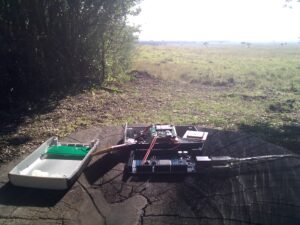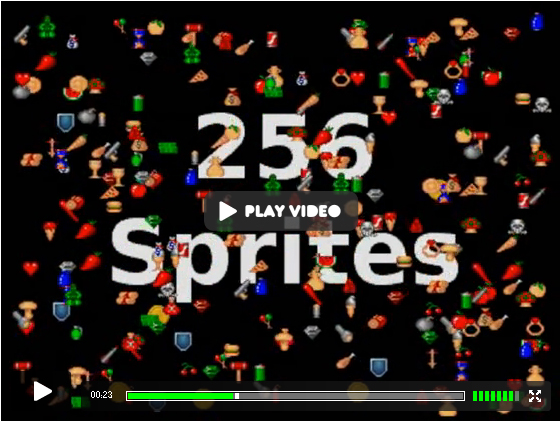GAMEDUINO BRINGS VINTAGE GAMING BACK
– March 1st, 2011
If Kickstarter is nowadays best place to find new (or upcoming) toys to dream about, Gameduino is probably one of the most amazing pieces of hardware I’ve seen hosted there. The shield mounts its own FPGA able of 80ies style graphics and sounds for creating old-school, 8-bit video-games, pre-loaded with numerous sprites and set up for easy connection to a VGA display.
Gameduino is a game adapter for Arduino – or anything else with an SPI interface – built as a single shield that stacks up on top of the Arduino and has plugs for a VGA monitor and stereo speakers.The sound and graphics are definitely old-school, but thanks to the latest FPGA technology, the sprite capabilities are a step above those in machines from the past.
- video output is 400×300 pixels in 512 colors
- all color processed internally at 15-bit precision
- compatible with any standard VGA monitor (800×600 @ 72Hz)
- background graphics
- 512×512 pixel character background
- 256 characters, each with independent 4 color palette
- pixel-smooth X-Y wraparound scroll
- foreground graphics
- each sprite is 16×16 pixels with per-pixel transparency
- each sprite can use 256, 16 or 4 colors
- four-way rotate and flip
- 96 sprites per scan-line, 1536 texels per line
- pixel-perfect sprite collision detection
- audio output is a stereo 12-bit frequency synthesizer
- 16 independent voices 10-4000 Hz
- per-voice sine wave or white noise
Have a look at the nice reference poster, its detailed hardware reference or its set of sample programs and library.
STAZIONE FUTURO, UN FABLAB TUTTO ITALIANO A TORINO
– February 28th, 2011

Il 17 Marzo inaugura la mostra StazioneFuturo alle “Officine Grandi Riparazioni” di Torino.
Dopo tante mostre sul passato si è pensato di guardare ad un futuro possibile per l’Italia mostrando le idee che già oggi sono sul territorio e che entreranno a far parte della nostra vita nei prossimi dieci anni.
La mostra è curata da Riccardo Luna di Wired che ne ha parlato già a novembre su ItalianValley.
Dopo tante mostre sul passato si è pensato di guardare ad un futuro possibile per l’Italia mostrando le idee che già oggi sono sul territorio e che entreranno a far parte della nostra vita nei prossimi dieci anni.
La mostra è curata da Riccardo Luna di Wired che ne ha parlato già a novembre su ItalianValley.
Riccardo ci ha chiesto di sviluppare l’area sul futuro del lavoro e noi abbiamo pensato che una mostra così doveva essere uno spazio vivo dove succedono delle cose. Perciò abbiamo deciso di organizzare un FabLab.
Cos’è un FabLab? un Fabrication Laboratory è un piccolo laboratorio dotato di una serie di macchine controllate da computer che permettono di fabbricare “quasi tutto”. Il concetto nasce da un corso dell’MIT di Boston insegnato da Neil Gershenfeld dove per anni hanno sperimentato come progettare e prototipare nuove tipologie di prodotti usando tecnologie che sembravano limitate alla produzione di massa.
Questo FabLab è a disposizione di tutti. Ci saranno corsi per imparare ad usare le macchine ma anche le tecnologie abilitanti il design digitale (come Processing, Arduino, SketchUp , Grasshopper, Rhino ed altri), Ospiti che ci spiegheranno come questo nuovo modo di lavorare impatterà sul nostro futuro e momenti in cui le macchine saranno utilizzabili da chi ci verrà a trovare.
Per poter far funzionare questo laboratorio abbiamo bisogno di voi!!
Il laboratorio è alla ricerca di 1 collaboratore a tempo pieno, 2 collaboratori part time ed un gruppo di volontari. I collaboratori impareranno ad utilizzare le macchine e le tecniche di design e produzione per poterle insegnare agli altri. Faranno parte dei workshop prima come studenti e poi come insegnanti.
Creeranno connessioni tra il lab e le realtà locali. per questo ci piacerebbe avere studenti delle università di Torino nel team.
Creeranno connessioni tra il lab e le realtà locali. per questo ci piacerebbe avere studenti delle università di Torino nel team.
Nei prossimi giorni inizieremo a selezionare le persone per il team, se siete interessati inviateci il vostro nominativo qui
Vorremmo cogliere l’occasione per ringraziare queste aziende che con la loro lungimiranza hanno supportato il progetto fornendo i macchinari : SEI , laRoland Italia , C.M.F. Marelli distributore italiano di Zcorp, F.T.A. e Tecnologie Aerodinamiche Srl per la depurazione.
UPDATE: Selezioni chiuse. Sono aperte solo più le richieste di volontari- Grazie per il grandissimo seguito.
DIY FABRIC SPEAKERS
– February 27th, 2011
Interesting DIY fabric speakers from Hannah Perner-Wilson:
Making a speaker is much easier than you’ve ever imagined, and what you need to prepare is merely: textile (or paper), conductive tape and some strong magnets. Try this one made by Hannah Perner-Wilson and you’ll find it quite impressive.
UPDATE: as Tara commented below, you can have more information about Hannah’s work on her website Kobakant.at
via [innewidea]
KIWI DRIVE THE SWEDISH HOUSEBOT
– February 23rd, 2011

Nice post from the latest Hackaton in Malmo Hackerspace:
For the Hackathon event last weekend, we wanted to build a robot and decided to go for a kiwi-drive. The kiwi-drive is a three wheel drive configurations that use special wheels to achieve omnidirectional movement. The robot was designed in Corel Draw (that’s what the laser cutter prefers) during the two weeks leading up to Hackathon and parts were purchased so that everything would be ready when the build started. We also moved the design from Corel Draw, via AutoCAD for cleanup, to SketchUp for a virtual test assembly and rendering to make sure everything would fit together.[...] The Arduino provides a simple serial interface and does all of the required drive calculations. It also provides an add-on interface that can be accessed using the same serial link and allows up to over a hundred expansions to easily be added to the system. The first two addons will be a battery voltage monitor and an emoticon display.
Want to build one? check the wiki of the ongoing project with part list and code (soon).
via [forskningsavd.se]
HALO FOR THE VISUALLY IMPAIRED
– February 23rd, 2011
Happy to discover the HALO project actually won the HUMANA Contest. Check out the other winners. HALO (Haptic Assisted Locating of Obstacles) is a solution for visually impaired people to perceive obstacles around them. Here’s a little description:
I recently watched an episode of Stan Lee’s Superhumans which featured a blind
man who used a series of clicks, like a bat, to echo locate his surroundings. I
got to thinking about other blind people and their ability to navigate freely –
without the use of a guide dog or cane. I came up with the idea to use a series
of rangefinders that would take input from sensors and output feedback to pulse
vibration motors placed on a person’s head. As a person gets closer to an object
the intensity and frequency of the vibration would increase – it’s directly
proportional to the distance of an object. If a region was lacking feedback,
then it would be safe to proceed in that direction.I call my submission the H.A.L.O. – the Haptic Assisted Locating of Obstacles. I
believe this can serve very useful for the visually impaired to have the freedom
to possibily move about hands-free without the assistance of a cane or seeing
eye dog. Technology has undoubtedly made our daily lives better. By using a few
inexpensive components and sensors, I’ve made a device that will allow the blind
to navigate their surroundings and avoid collisions.
LIONS AND FARMERS AND ARDUINOS! OH MY!
– February 20th, 2011
Benedetta and Justin at Groundlabs sent us this great photo of a Mega they used in the Masai Mara in Kenya recently while testing some open source lion tracking collars they are developing for clients there and in Tanzania.
 Groundlab does R&D for not-for-profit organizations, and uses AVR processors a lot, both in Arduinos and in their own custom boards. Groundlab’s collars use GSM modems, and ever the good open source community citizens, they’ve posted a wiki with their librariesand tutorials which may be very useful for people developing similar modems, or any AT-style interface. They’re also linked off the playground under Interfacing with Hardware. Besides the GSM stuff, they’ve got some good examples for Telit modems, using CodeBlocks with AVRs and Arduino, and more.
Groundlab does R&D for not-for-profit organizations, and uses AVR processors a lot, both in Arduinos and in their own custom boards. Groundlab’s collars use GSM modems, and ever the good open source community citizens, they’ve posted a wiki with their librariesand tutorials which may be very useful for people developing similar modems, or any AT-style interface. They’re also linked off the playground under Interfacing with Hardware. Besides the GSM stuff, they’ve got some good examples for Telit modems, using CodeBlocks with AVRs and Arduino, and more.FITBIT: ARDUINO IN THE WORKPLACE
– February 18th, 2011
FitBit is a company that makes a nifty little activity tracking device that lets you track your walking, running, sleeping, and general activity based on movement. We had a nice note from Shelten Yuen to say “We’ve been using Arduino for rapid prototyping for a few years now. It’s been a great tool for us in trying things out quickly.” It’s always nice to hear how people use Arduino at work as well as in their hobbies. Thanks Shelten and thanks Christine Brumback for the intros.
Shelten also mentioned that FitBit is hiring.
TINY FEMTODUINO, THE SMALLEST ARDUINO COMPATIBLE BOARD
– February 17th, 2011

Some time ago I’ve been reading about the smallest Tv-B-Gone, and as I ran into [Fabio Varesano]‘s projects (Thankyou Enkel!) I was amazed in seeing probably the smallest Arduino compatible board.
By using the QFN32 version of the ATMEGA 328p, 0.05″ connectors, 0402 components and removing everything not strictly necessary, I’ve been able to design and hand build an Arduino compatible board which is very small (20.7×15.2 mm) and ultra light (2g) but has exactly the same computing power of the Arduino Duemilanove or UNO.
GREAT WORK FROM OCAD STUDENTS
– February 17th, 2011
Kate Hartman’s students at Ontario College of Art & Design have been doing some excellent projects using wearable technology to examine our relationship to our bodies. Using sewable circuits, LilyPad Arduinos, and a lot of creative thought, they’ve come up with a range of projects, some thought-provoking, some humorous, some both, that will make you think twice about your body.
I am Woman hear me beep by Amanda Almeida, Erin Lewis, Loretta Faveri

The Shoulder by Michael Vaughan, Andrea Rataj, Hira Gardezi

The Heart Chakra by Katherine Dark, Hilary Hayes-Wilson, and Ken Leung

The Nipple byRachel Kess & Elija Hayden Montgomery

Check out the Social Wearables as well.
FIX TO UNO AND MEGA 2560 LINUX SERIAL PROBLEMS
– February 15th, 2011
We’ve just posted a tutorial on upgrading the firmware on the ATmega8U2 on the Arduino Uno and Mega 2560. This should resolve the problems that some of you have had with serial communication between those boards and Linux. The upgrade doesn’t require a programmer or other hardware, just adding a resistor to the board and touching a couple of pins together. It’s a safe process, and if it doesn’t work the first time you can do it again.
We’re in the process of testing the new firmwares on other operating systems so that we can begin to ship them as the default on new boards. So far, though, many Linux users have had success with the upgraded firmwares.
Thanks to Dean Camera (author of LUFA) for his help in fixing the firmware.










0 comentarios:
Publicar un comentario